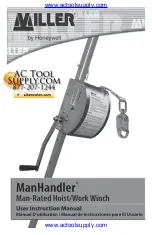
Installation and operating manual
G961.1 - 03/2012
EN-9
Item
Name
Function
3
EMERGENCY-
STOP button
Switching on:
–
Turn the button to the right until it
releases
Disconnecting power supply:
–
Press the button in
With two speeds:
4
UP button
Move load upwards /pull rope:
–
Press the button halfway and hold:
slow
–
Press the button completely and
hold:
fast
5
DOWN button
Move load downwards / release rope:
–
Press the button halfway and hold:
slow
–
Press the button completely and
hold:
fast
6
EMERGENCY-
STOP button
See Point 3.
Operation by remote control
Refer to Fig. 3.
Item
Name
Function
1
On/Off switch
Switches the radio remote control on or
off
2
–
No function
3
Stop button
Turn on the device:
–
Turn the button to the right until it
releases
Disconnecting power supply:
–
Press the button in
4
Joystick
Move load upwards /pull rope:
–
Move the joystick to the rear
Move load downwards / release rope:
–
Move the joystick to the front
5
Key-switch
Activating the remote control:
–
Turn the key
4.7
Safety equipment
EMERGENCY-STOP button
Press the EMERGENCY-STOP button to stop the hoist immedi-
ately in an emergency situation.
Mechanical load limiting device
X-Model series:
y
above 1,000 kg maximum working load included in the
equipment supplied
y
up to 1,000 kg maximum working load as optional scope of
delivery
The load limiting device will activate automatically when the
overload setting is reached. The upward travel of the hoist is
stopped. The maximum overload that has to be set up can be
found in the applicable directives and standards (See
'9.1 Directives and standards' on Page 11).
The system manufacturer / operator is responsible for determi-
ning and setting up the application dependent maximum overload.
For further information see '15.5 Adjustment, Adjusting the load
limiting device' on Page 23.
Electric load limiting device (optional)
The electric load limiting device switches off automatically in
case of an overload. The load limiting device reacts to the power
consumption of the motor. Hoists with two speeds are equipped
with two electric load limiting devices. An overload is recognized
when lifting.
Spring-applied brake
The electromagnetic spring-applied brake automatically locks
when the operating control for travelling UP or DOWN is released
or when the power fails.
Centrifugal brake
A centrifugal brake on the motor shaft of the hoist ensures that
the load is not lowered too fast when the spring-applied brake on
the hoist’s motor is released manually.
Secondary brake
The optional secondary brake BSO is mounted in or in front of
the support frame, serves as a speed limiting device and pre-
vents the load from falling in the event of broken gears, for ex-
ample. If the secondary brake is triggered the hoist is switched
off and the suspension rope caught.
The secondary brake continually monitors the speed at which the
suspension rope is running. The clamping mechanism automati-
cally locks if the speed suddenly increases.
SAFETY-STOP button (secondary brake)
Press the SAFETY-STOP button to manually trigger the secon-
dary brake in an emergency situation.
Running hours counter
The running hours can be read from the running hours counter,
in order to determine when the next hoist safety check must be
carried out.
Phase sequence relay (hoists without frequency converters)
In control units operating by three-phase current, the phase
sequence relay shuts down the system in the case of an incor-
rect phase sequence and this prevents an UP / DOWN travel
direction mix-up, which could potentially disable the limit switches
and load limiting devices.
Summary of Contents for Tirak MWX 1020
Page 5: ...MWX 500 1537 G961 1 03 2012 EN DE FR NL V Fig Abb Fig Afb 1 ...
Page 12: ...MWX 500 1537 EN DE FR NL XII G961 1 03 2012 ...
Page 42: ...Installation and operating manual EN 30 G961 1 03 2012 ...
Page 133: ......
Page 134: ......
Page 135: ......
Page 136: ...G961 1 03 2012 105110 EN DE FR NL TRACTEL Greifzug GmbH ...





































